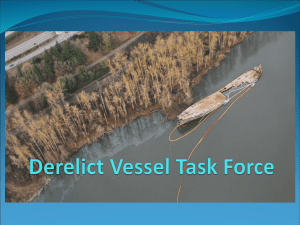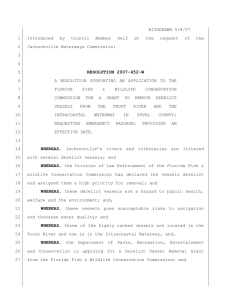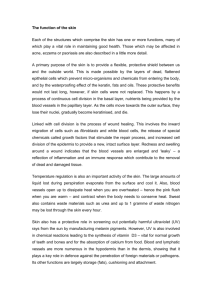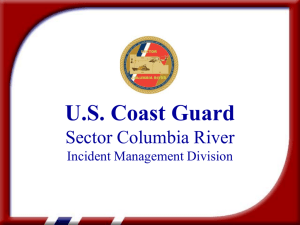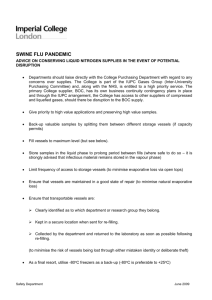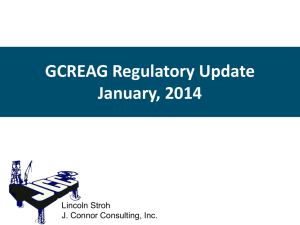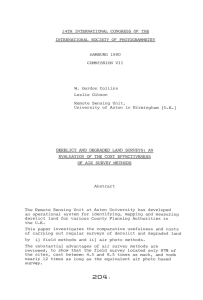Derelict Vessel Task Force Charter
advertisement
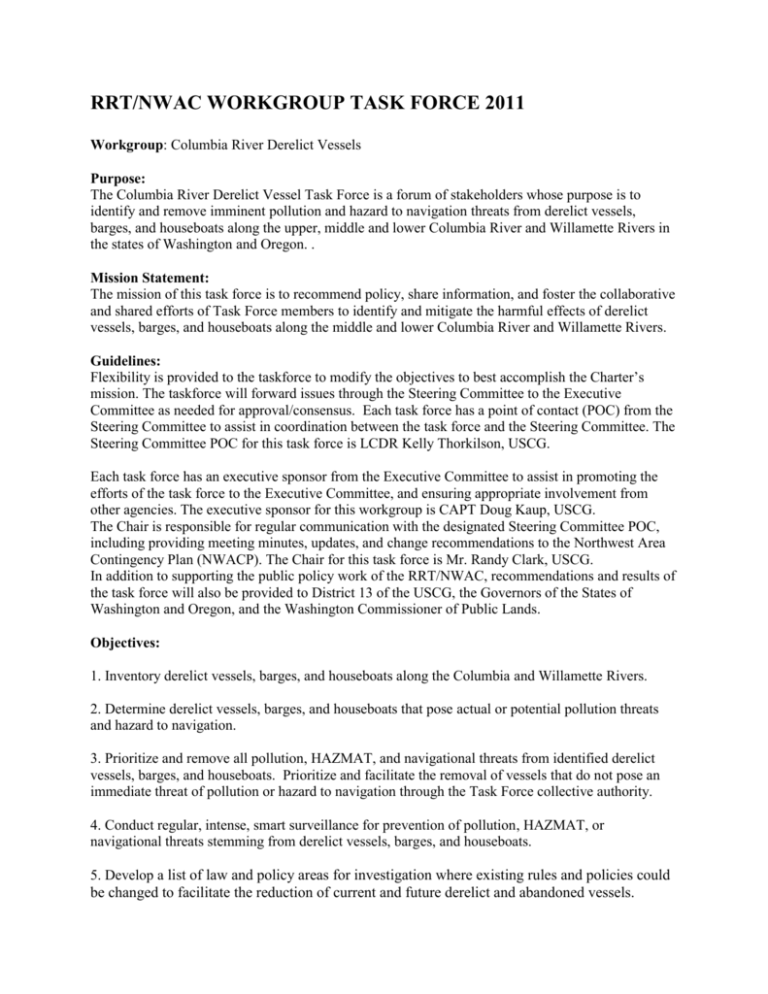
RRT/NWAC WORKGROUP TASK FORCE 2011 Workgroup: Columbia River Derelict Vessels Purpose: The Columbia River Derelict Vessel Task Force is a forum of stakeholders whose purpose is to identify and remove imminent pollution and hazard to navigation threats from derelict vessels, barges, and houseboats along the upper, middle and lower Columbia River and Willamette Rivers in the states of Washington and Oregon. . Mission Statement: The mission of this task force is to recommend policy, share information, and foster the collaborative and shared efforts of Task Force members to identify and mitigate the harmful effects of derelict vessels, barges, and houseboats along the middle and lower Columbia River and Willamette Rivers. Guidelines: Flexibility is provided to the taskforce to modify the objectives to best accomplish the Charter’s mission. The taskforce will forward issues through the Steering Committee to the Executive Committee as needed for approval/consensus. Each task force has a point of contact (POC) from the Steering Committee to assist in coordination between the task force and the Steering Committee. The Steering Committee POC for this task force is LCDR Kelly Thorkilson, USCG. Each task force has an executive sponsor from the Executive Committee to assist in promoting the efforts of the task force to the Executive Committee, and ensuring appropriate involvement from other agencies. The executive sponsor for this workgroup is CAPT Doug Kaup, USCG. The Chair is responsible for regular communication with the designated Steering Committee POC, including providing meeting minutes, updates, and change recommendations to the Northwest Area Contingency Plan (NWACP). The Chair for this task force is Mr. Randy Clark, USCG. In addition to supporting the public policy work of the RRT/NWAC, recommendations and results of the task force will also be provided to District 13 of the USCG, the Governors of the States of Washington and Oregon, and the Washington Commissioner of Public Lands. Objectives: 1. Inventory derelict vessels, barges, and houseboats along the Columbia and Willamette Rivers. 2. Determine derelict vessels, barges, and houseboats that pose actual or potential pollution threats and hazard to navigation. 3. Prioritize and remove all pollution, HAZMAT, and navigational threats from identified derelict vessels, barges, and houseboats. Prioritize and facilitate the removal of vessels that do not pose an immediate threat of pollution or hazard to navigation through the Task Force collective authority. 4. Conduct regular, intense, smart surveillance for prevention of pollution, HAZMAT, or navigational threats stemming from derelict vessels, barges, and houseboats. 5. Develop a list of law and policy areas for investigation where existing rules and policies could be changed to facilitate the reduction of current and future derelict and abandoned vessels. 6. Identify opportunities to align Washington and Oregon laws addressing derelict vessels with the goal of moving toward a consistent regulatory regime on the Columbia River. 7. Maintain effective communications with state and local agencies, CG Auxiliary, and Federal partners. Anticipated Work Products/Deliverables: 1. Develop a working inventory of derelict vessels presenting actual or potential pollution threats or hazards to navigation. 2. Address pollution threats and navigational hazards, i.e., implement actions required to mitigate identified threats and hazards from derelict vessels, developing case studies and success stories. 3. Develop a shared understanding of the current authorities and abilities of state and federal agencies to prevent and address problems caused by derelict vessels and facilitate collaboration of the agencies consistent with these current authorities and abilities. The Task Force may recommend policies and future initiatives for future consideration of the RRT/NWAC and other entities. 4. Sponsor workshops to inform, engage and solicit input from other stakeholders interested in addressing the problems presented by derelict vessels. 5. Host a progress report briefing for the Governors of Oregon and Washington and the Washington Commissioner of Public Lands to include a site visit and/or over flight of identified Columbia River derelict vessels. 6. Provide progress reports on each of the preceding activities at the October RRT/NWAC meeting. Task Force Members CAPT Douglas E. Kaup, USCG Sector Columbia River Captain of the Port and NWAC CO-Chair (Executive Sponsor) douglas.e.kaup@uscg.mil LCDR Kelly Thorkilson, Sector Columbia River Incident Management Chief (NWAC Steering Committee POC) kelly.a.thorkilson@uscg.mil Mr. Randy Clark, Sector Columbia River Marine Transportation Recovery and Salvage Planner (Task Force Chairman) william.r.clark@uscg.mil Rachel Bullene, Oregon State Marine Board Oregon Clean Marina Coordinator rbullene@osmb.state.or.us Dave Byers, Washington Department of Ecology, Spill Response Section Manager dbye461@ecy.wa.gov Jeff Christensen, Oregon Department of Environmental Quality, Manager Emergency Response/Environmental Cleanup, Land Quality Division christensen.jeff@deq.state.or.us Melissa Montgomery Ferris, Washington State Department of Natural Resources, Derelict Vessel Removal Program Manager melissa.ferris@dnr.wa.gov Richard Franklin, EPA Federal On-Scene Coordinator Franklin.Richard@epamail.epa.gov Nancy Pustis Oregon Division of State Lands, Western Region Manager Nancy.pustis@state.or.us Louise Solliday, Director, Oregon State Lands Louise.c.solliday@dsl.state.or.us Ruth Yender, NOAA Scientific Support Coordinator Ruth.Yender@noaa.gov Eric Braun, Army Corps of Engineers Eric.P.Braun@usace.army.mil
